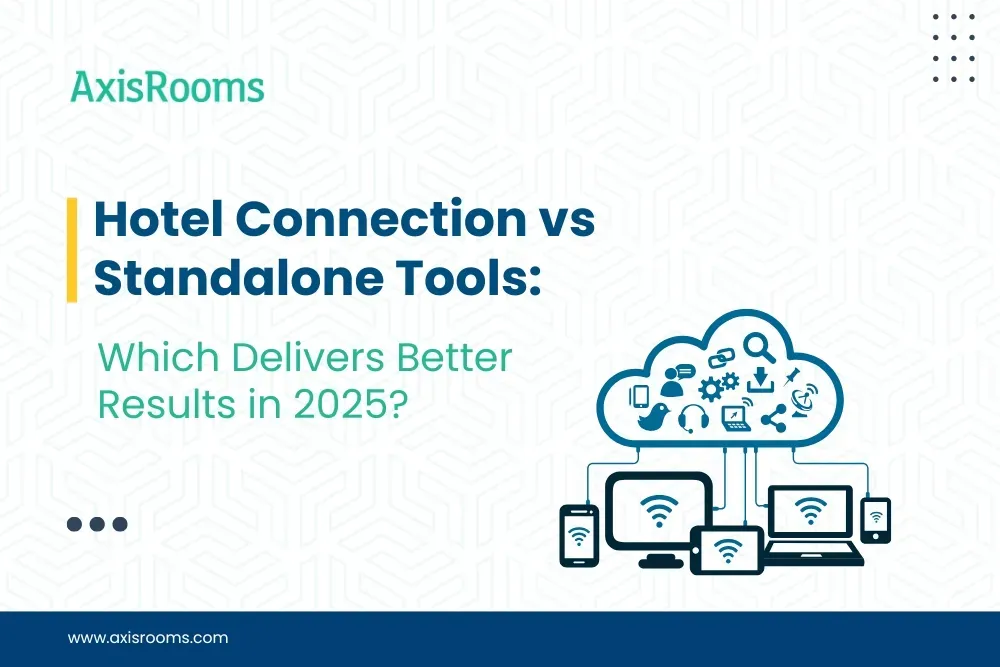Why Hotel Connection Systems Are Winning in 2025
Hotels that have adopted fully connected technology platforms are outperforming competitors still relying on disjointed or legacy tools. Here’s why:
- Faster Operational Decisions
Real-time data flow between systems—like PMS, channel manager, and booking engine—enables quicker, more informed decision-making across departments.
- Centralized Rate and Inventory Management
Hoteliers can manage rates and room availability from a single dashboard, cutting down delays and inconsistencies across OTA channels.
- Improved Guest Experience
With seamless backend operations, staff can focus more on service delivery and less on technical issues, leading to better guest satisfaction.
- Fewer Manual Errors Automation reduces human error in rate updates, inventory management, and reservation tracking, which helps avoid costly mistakes like double bookings or price mismatches.
- Real-Time Market Responsiveness Hotels can adjust pricing or availability instantly based on demand spikes, cancellations, or competitive shifts—maximizing revenue opportunities.
According to recent industry analysis, hotels implementing AI-enhanced revenue management systems have seen RevPAR increases of 5-10% by moving toward dynamic pricing and personalization strategies.
- Operational Efficiency Across Teams Front desk, reservations, and revenue teams all access the same up-to-date information, improving coordination and accountability.
- Stronger OTA and Direct Booking Performance Accurate, synced listings help maintain rate parity, avoid OTA penalties, and increase visibility—resulting in more bookings across all channels.
Hotel Connection vs. Standalone Tools: Key Differences
What Is a Hotel Connection Platform?
What Are Standalone Hotel Tools?
Standalone hotel tools are individual systems—like a separate booking engine, channel manager, or RMS—that don’t communicate with each other. While each may perform its core task, they hotel operate in isolation, often requiring manual coordination to keep information updated across systems.
This disjointed setup can lead to common issues such as mismatched rates on OTAs, double bookings due to delayed inventory updates, and extra workload for your front office and reservation staff. As hotel operations grow more complex, these inefficiencies compound, making it harder to respond quickly to market changes or manage multiple distribution channels effectively. In today’s fast-paced environment, standalone tools can hold your property back.
Benefits of Moving to a Fully Connected Platform

Real-Time Booking Sync Avoid overbookings with instant updates across all distribution channels.
Centralized Rate Management Change your rates once—have them reflected everywhere without delay.
Higher OTA Visibility Accurate availability and rate parity improve OTA rankings and booking volumes.
Reduced Operational Errors Automation eliminates manual mistakes and staff workload during peak shifts.
B2B Enablement Easily share live inventory with travel agents and corporate partners.
According to revenue management experts, in 2025 the leading challenges for hotels include rising costs, shrinking profits, and adapting to market shifts—making the way we approach pricing, technology, and data integration critical for success.
The Risks of Relying on Standalone Tools in 2025
Rate Parity Penalties Out-of-sync rates can trigger penalties and lower OTA placement.
Double Bookings Delayed inventory syncs often result in overlapping reservations.
Lost Direct Revenue Outdated website prices discourage direct bookings and lower conversion.
Manual Reconciliation Workload Staff spends unnecessary time verifying bookings and rates from different systems.
Siloed Reporting With no central view, revenue and performance data remain scattered and unreliable.
Why Integrated Platforms Drive Better Results
Hotels that adopt integrated platforms typically see a 10–15% boost in Average Daily Rate (ADR), improved OTA visibility, and smoother day-to-day operations. With real-time syncing between systems, staff no longer need to rely on manual updates or guesswork. General Managers, front desk teams, and revenue managers can make faster, data-driven decisions that positively impact occupancy and profitability. Instead of reacting to errors or delays, hotels can stay ahead of market shifts and guest expectations—proactively managing performance across all channels. These connected systems are essential to building a sustainable hotel revenue strategy.
How AxisRooms Helps Hoteliers Build Smarter Connections
For hoteliers who want to spend less time managing systems and more time growing revenue, AxisRooms provides a fully connected platform that simplifies distribution and pricing.
- Channel Manager: Pushes live rates and inventory to 100+ OTAs
- Revenue Management System: Recommends optimal rates based on real-time demand
- Booking Engine: Converts direct traffic through accurate room availability and rates
- Multi-Property Support: Centralized controls for chains and hotel groups
- AxisRooms also supports PMS integrations, allowing all hotel operations to function cohesively with existing tools—boosting speed, accuracy, and team efficiency.
AxisRooms removes the operational friction from daily tasks—so your team can focus on occupancy, guest satisfaction, and profitability.
Top 5 FAQs: Hotel Connection Platforms for 2025
Q1 : Why are connected systems better than standalone tools?
A: They enable real-time updates, reduce manual workload, and improve performance across all sales channels.
Q2 : Is AxisRooms suitable for smaller hotels too?
A: Absolutely. The platform is designed to scale with your needs, from boutique properties to large chains.
Q3: How does AxisRooms improve OTA visibility?
A: By syncing availability and pricing instantly, your property maintains rate parity and improves its listing rank.
Q4 : Is onboarding complex?
A: No. AxisRooms provides dedicated implementation support for a smooth transition from legacy tools.
Q1 : What ROI can hotels expect?
A: Hotels typically see increased direct bookings, improved ADR, and reduced OTA penalties within a few months.
Final Thoughts: Connectivity Is Now a Competitive Edge
In 2025, operational speed, accuracy, and responsiveness define a hotel’s competitive edge—and all of that depends on system connectivity. Relying on manual processes or disjointed tools slows you down and puts revenue at risk.
With AxisRooms, hotels gain more than just automation; they adopt a fully integrated strategy that enhances team productivity, supports multi-channel growth, and delivers measurable improvements in occupancy, ADR, and guest experience.


